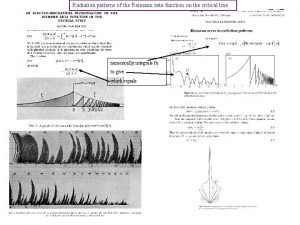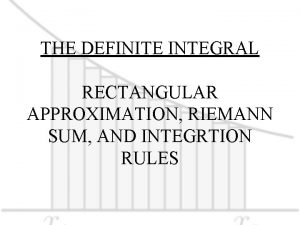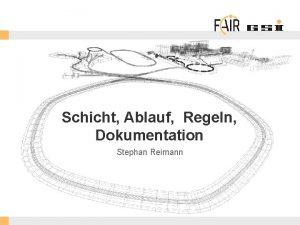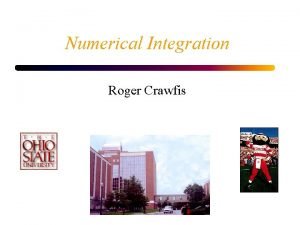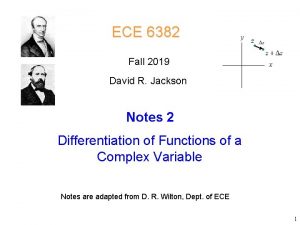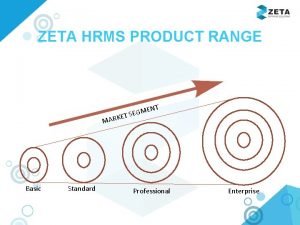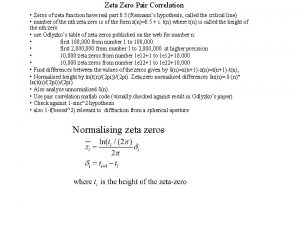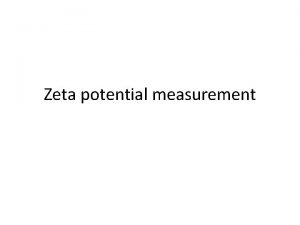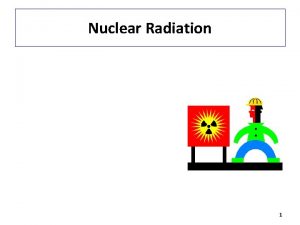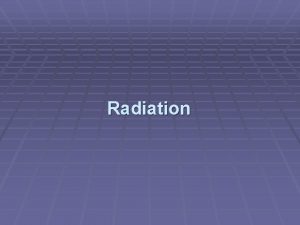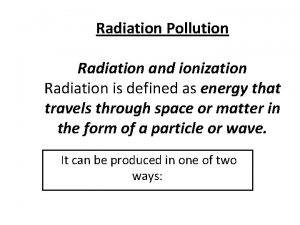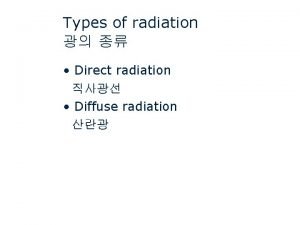Radiation patterns of the Reimann zeta function on

















- Slides: 17

Radiation patterns of the Reimann zeta function on the critical line numerically integrate fu to give which equals

Dipole array in formed in y direction • a discrete number of dipoles are arranged into an antenna array with amplitudes given by a discrete f(u) • to save time and it is difficult to compute a real array of many dipoles since it requires too much computer memory and take too long, so just compute pattern of one dipole and then use the arraying facility to produce a simulated array pattern. This will be very similar to a real array provided the dipoles are relatively far apart in order to diminish mutual coupling. note: when I moved in y I called files _dx then after I computed I changed the heading to be dy to be consistent with what I actually did according to axis on left but plots still show _dx

Single dipole radiation pattern

To get f(u) text file run mathematica 'output fu text files for cst. nb' select range of points for fu. Mathematica then outputs the fu. txt file. In cst - dipole. cst run farfield array with fu. txt as amplitude weights. Use macroarray - set array farfield button then user defined amplitude and point to fu. txt. set array with number of points given by mathematica. Choose point separation x 0 to give an array scaling about k x 0 dt= say 40. This will give heights of the zeta zero up to about t=40. e. g u+-3 step 0. 01 601 points du=0. 01, dt=1/du=100 run array pattern in say x with dx separation between u points of 100 mm. This dx *dt is called x 0 by Berry. tmax=k*xo=k*dx*dt where k = 2 pi/wavelength for 1 GHz lambda=300 mm so k = 2 pi/300 ~0. 02 therefore tmax = (0. 02*100)=200 so can view radiation pattern nulls=zeta zeros for t up to 200. Export pattern into /maths/mathematica/zeta function and reiman hypothesis/array zeta zero analysis/cst van der pol edit pattern. txt so just 0 to 90. data-import into excel array_comp_1 ghz. Read off angles of nulls (theta(n)) which can then be used to compute t(n) of the nth zeta zero from t(n)=sin theta(n)*k*dx*dt. Brian 14/2/2017

3 D Radiation Pattern at 1 GHz: f(u) = ± 3 step 0. 01 dy=25 mm

3 D Radiation Pattern at 1 GHz: f(u) = ± 5 step 0. 01 dy=25 mm

3 D Radiation Pattern at 1 GHz: f(u) = ± 10 step 0. 01 dy=25 mm

3 D Radiation Pattern at 1 GHz: f(u) = ± 15 step 0. 01 dy=25 mm

Cartesian Radiation Pattern at 1 GHz: f(u) = ± 3, ± 5, ± 10, ± 15 step 0. 01 dy=25 mm should be dy theta (deg)

Cartesian Radiation Pattern at 1 GHz: f(u) = ± 3, ± 5, ± 10, ± 15 step 0. 01 dy=25 mm Sixth Zeta Zero @45. 817º First Zeta Zero @15. 645º Zoomed into pattern nulls ‘pulling-off’ of zero near 90 deg Tenth Zeta Zero @71. 742º

Dipole array in formed in x direction

3 D Radiation Pattern at 1 GHz: f(u) = ± 10 step 0. 01 dx=25 mm H Bomb Test

Cartesian Radiation Pattern at 1 GHz: f(u) = ± 10 step 0. 01 dx=25 mm and dy=25 mm Comparison dipole array in x and y tenth zero still at 71. 3 deg instead 71. 7

Comparing CST Array Radiation Pattern of f(u) with discrete fourier transform of f(u) Dipole array Cartesian radiation pattern at 1 GHz: f(u) = ± 3, ± 5, ± 10, ± 15 step 0. 01 dy=25 mm ANTENNA SOFTWARE f(u) range ± 3, ± 5, ± 10, ± 15 for u step = 0. 01 deg matlab DFT Discrete Fourier Transform of f(u). Power spectrum g(t)= 10 log 10(FT[|f(u)|^2) = ± 3, ± 5, ± 10, ± 15 step 0. 01

Comparing numerical integration of f(u) ± 5 step 1. 047 with discrete (antenna sampled) fourier transform of f(u) ± 5 step 0. 01 (equivalent dt=1. 047). Both power spectra loge(amp^2) t f(u) ± 5 Purple is numerical integration MATHEMATICA Blue is discrete FFT -MATLAB

Comparing numerical integration of f(u) ± 10 step 0. 318 with discrete (antenna sampled) fourier transform of f(u) ± 10 step 0. 01 (equivalent dt=0. 318). Both power spectra i. e loge(amp^2) t f(u) ± 10 Purple is numerical integration MATHEMATICA Blue is discrete FFT -MATLAB

Comparing numerical integration of f(u) ± 15 step 0. 209 with discrete (antenna sampled) fourier transform of f(u) ± 15 step 0. 01 (equivalent dt=0. 209). Both power spectra i. e loge(amp^2) t f(u) ± 15 Purple is numerical integration MATHEMATICA Blue is discrete FFT -MATLAB
 Reimann zeta function
Reimann zeta function How to do riemann sum
How to do riemann sum Gsi olog
Gsi olog Contoh soal metode kuadratur gauss
Contoh soal metode kuadratur gauss Gauss quadrature formula
Gauss quadrature formula Integrasi numerik
Integrasi numerik Cr equation in polar form
Cr equation in polar form Dating patterns since the 1960s are
Dating patterns since the 1960s are Associations and correlations in data mining
Associations and correlations in data mining Zeta phi beta national prayer
Zeta phi beta national prayer Zeta hrms kcm appliances
Zeta hrms kcm appliances Mercatone zeta ancona
Mercatone zeta ancona Zeta green air purifier
Zeta green air purifier Zol zeta phi beta
Zol zeta phi beta Zeta.nu
Zeta.nu Phi pi omega chapter of aka
Phi pi omega chapter of aka Zeta hrms choice foundation
Zeta hrms choice foundation Rizol epsilon
Rizol epsilon
